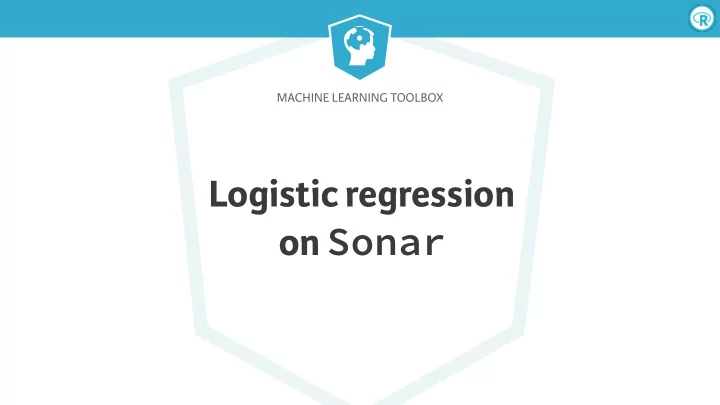

MACHINE LEARNING TOOLBOX Logistic regression on Sonar
Machine Learning Toolbox Classification models ● Categorical (i.e. qualitative) target variable ● Example: will a loan default? ● Still a form of supervised learning ● Use a train/test split to evaluate performance ● Use the Sonar dataset ● Goal: distinguish rocks from mines
Machine Learning Toolbox Example: Sonar data > # Load the Sonar dataset > library(mlbench) > data(Sonar) > # Look at the data > Sonar[1:6, c(1:5, 61)] V1 V2 V3 V4 V5 Class 1 0.0200 0.0371 0.0428 0.0207 0.0954 R 2 0.0453 0.0523 0.0843 0.0689 0.1183 R 3 0.0262 0.0582 0.1099 0.1083 0.0974 R 4 0.0100 0.0171 0.0623 0.0205 0.0205 R 5 0.0762 0.0666 0.0481 0.0394 0.0590 R 6 0.0286 0.0453 0.0277 0.0174 0.0384 R
Machine Learning Toolbox Spli � ing the data ● Randomly split data into training and test sets ● Use a 60/40 split, instead of 80/20 ● Sonar dataset is small, so 60/40 gives a larger, more reliable test set
Machine Learning Toolbox Spli � ing the data # Randomly order the dataset > rows <- sample(nrow(Sonar)) > Sonar <- Sonar[rows, ] # Find row to split on > split <- round(nrow(Sonar) * .60) > train <- Sonar[1:split, ] > test <- Sonar[(split + 1):nrow(Sonar), ] # Confirm test set size > nrow(train) / nrow(Sonar) [1] 0.6009615
MACHINE LEARNING TOOLBOX Let’s practice!
MACHINE LEARNING TOOLBOX Confusion matrix
Machine Learning Toolbox Confusion matrix Reference Yes No Prediction True positive False positive Yes False negative True negative No
Machine Learning Toolbox Confusion matrix # Fit a model > model <- glm(Class ~ ., family = binomial(link = "logit"), train) > p <- predict(model, test, type = "response") > summary(p) Min. 1st Qu. Median Mean 3rd Qu. Max. 0.0000 0.0000 0.9885 0.5296 1.0000 1.0000 # Turn probabilities into classes and look at their frequencies > p_class <- ifelse(p > .50, "M", "R") > table(p_class) p_class M R 44 39
Machine Learning Toolbox Confusion matrix ● Make a 2-way frequency table ● Compare predicted vs. actual classes # Make simple 2-way frequency table > table(p_class, test[["Class"]]) p_class M R M 13 31 R 30 9
Machine Learning Toolbox Confusion matrix # Use caret’s helper function to calculate additional statistics > confusionMatrix(p_class, test[["Class"]]) Reference Prediction M R M 13 31 R 30 9 Accuracy : 0.2651 95% CI : (0.1742, 0.3734) No Information Rate : 0.5181 P-Value [Acc > NIR] : 1 Kappa : -0.4731 Mcnemar's Test P-Value : 1 Sensitivity : 0.3023 Specificity : 0.2250 Pos Pred Value : 0.2955 Neg Pred Value : 0.2308
MACHINE LEARNING TOOLBOX Let’s practice!
MACHINE LEARNING TOOLBOX Class probabilities and class predictions
Machine Learning Toolbox Di ff erent thresholds ● Not limited to 50% threshold ● 10% would catch more mines with less certainty ● 90% would catch fewer mines with more certainty ● Balance true positive and false positive rates ● Cost-benefit analysis
Machine Learning Toolbox Confusion matrix # Use a larger cutoff > p_class <- ifelse(p > .99, "M", "R") > table(p_class) p_class M R 41 42 # Make simple 2-way frequency table > table(p_class, test[["Class"]]) p_class M R M 13 28 R 30 12
Machine Learning Toolbox Confusion matrix with caret # Use caret to produce confusion matrix > confusionMatrix(p_class, test[["Class"]]) Reference Prediction M R M 13 28 R 30 12 Accuracy : 0.3012 95% CI : (0.2053, 0.4118) No Information Rate : 0.5181 P-Value [Acc > NIR] : 1.0000 Kappa : -0.397 Mcnemar's Test P-Value : 0.8955 Sensitivity : 0.3023 Specificity : 0.3000 Pos Pred Value : 0.3171 Neg Pred Value : 0.2857
MACHINE LEARNING TOOLBOX Let’s practice!
MACHINE LEARNING TOOLBOX Introducing the ROC curve
Machine Learning Toolbox The challenge ● Many possible classification thresholds ● Requires manual work to choose ● Easy to overlook a particular threshold ● Need a more systematic approach
Machine Learning Toolbox ROC curves ● Plot true/false positive rate at every possible threshold 100% true positive rate vs. ● Visualize tradeo ff s between two extremes 0% false positive rate ● Result is an ROC curve ● Developed as a method for analyzing radar signals
Machine Learning Toolbox An example ROC curve # Create ROC curve > library(caTools) > colAUC(p, test[["Class"]], plotROC = TRUE) ● X-axis: false positive rate ● Y-axis: true positive rate ● Each point along the curve represents a di ff erent threshold
MACHINE LEARNING TOOLBOX Let’s practice!
MACHINE LEARNING TOOLBOX Area under the curve (AUC)
Machine Learning Toolbox From ROC to AUC
Machine Learning Toolbox Defining AUC ● Single-number summary of model accuracy ● Summarizes performance across all thresholds ● Rank di ff erent models within the same dataset
Machine Learning Toolbox Defining AUC ● Ranges from 0 to 1 ● 0.5 = random guessing ● 1 = model always right ● 0 = model always wrong ● Rule of thumb: AUC as a le � er grade ● 0.9 = "A" ● 0.8 = "B" ● …
MACHINE LEARNING TOOLBOX Let’s practice!
Recommend
More recommend